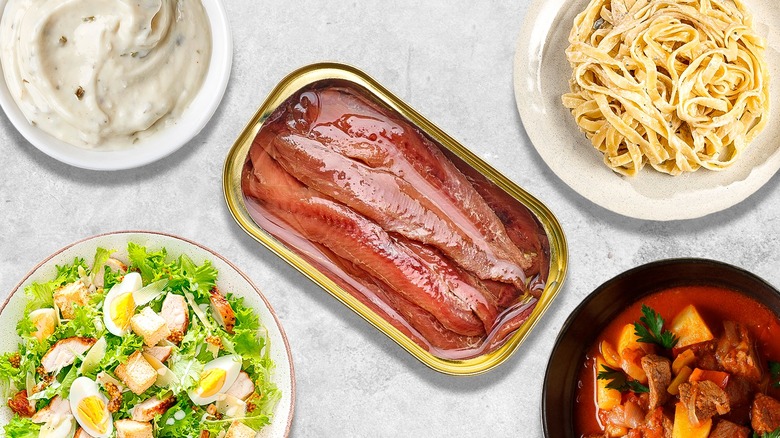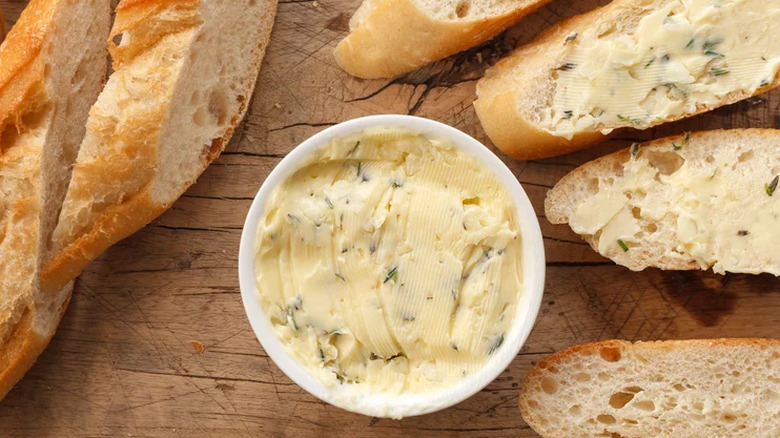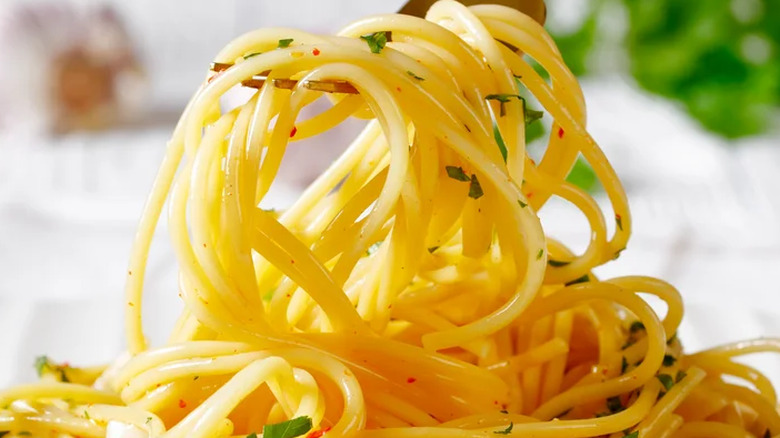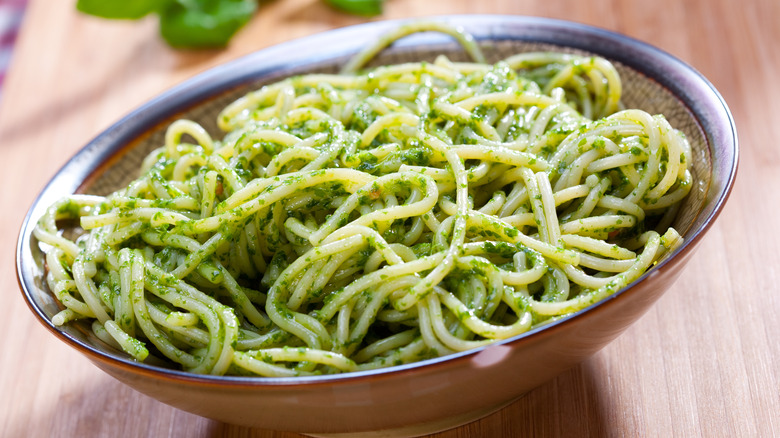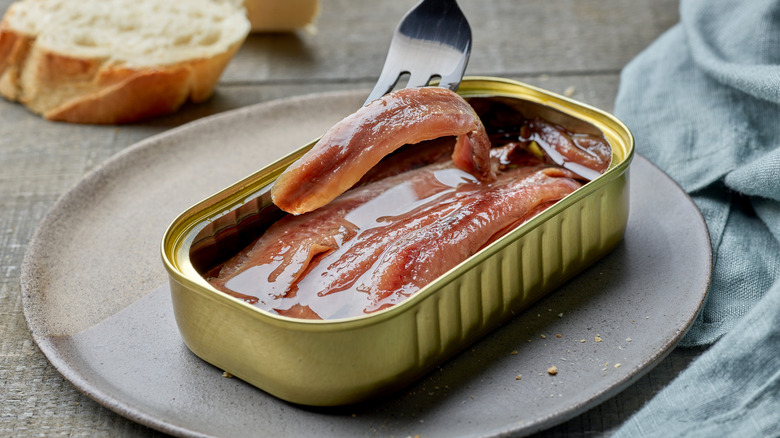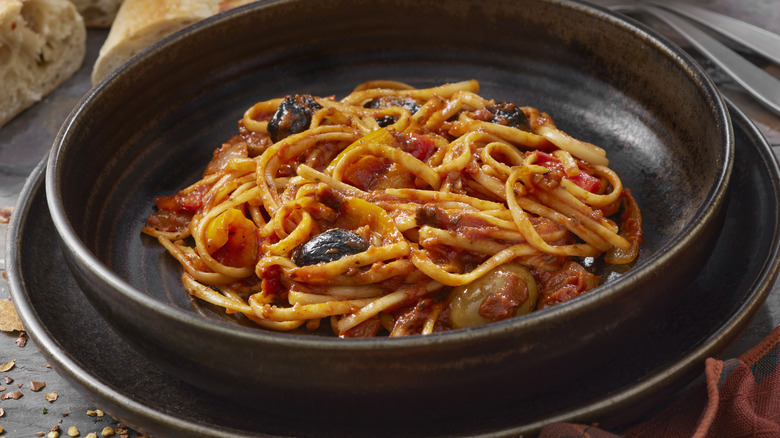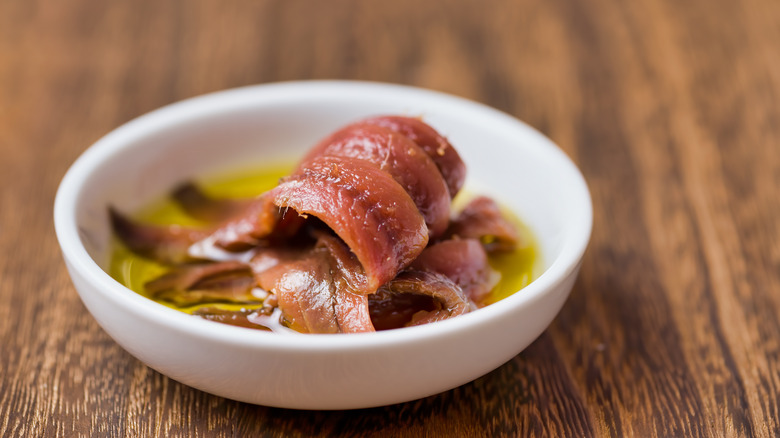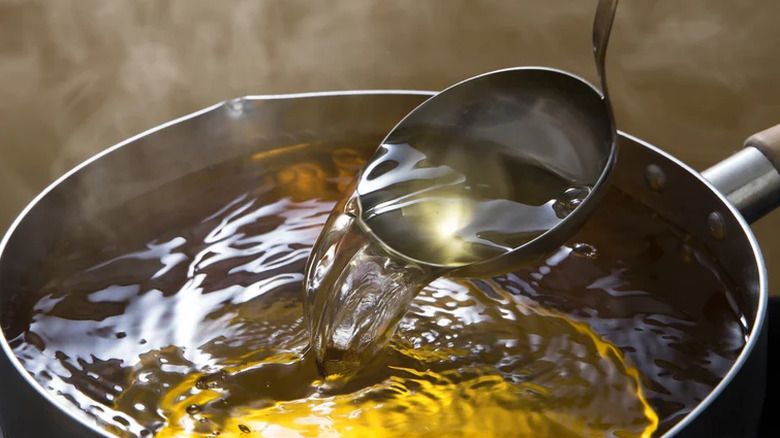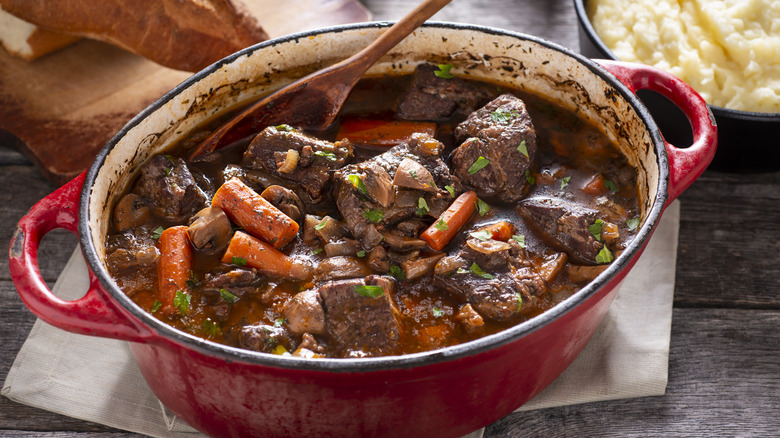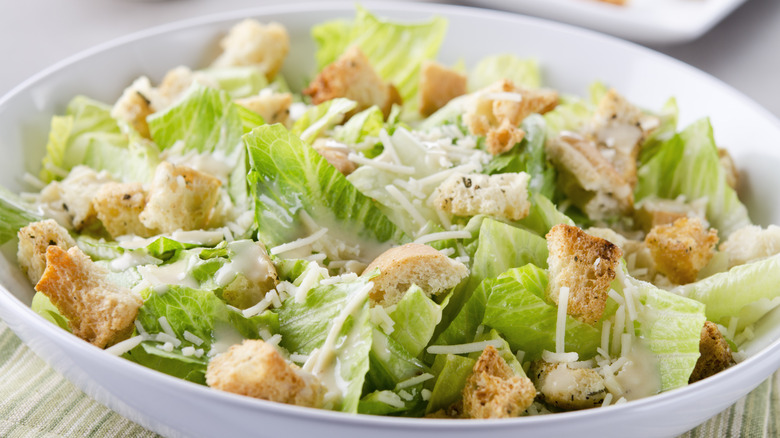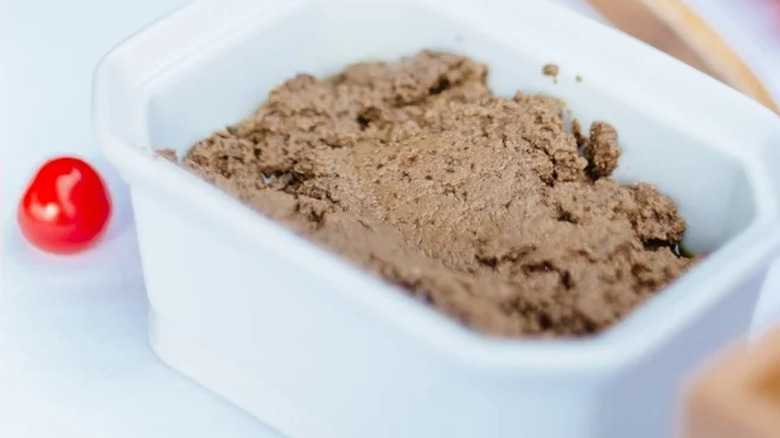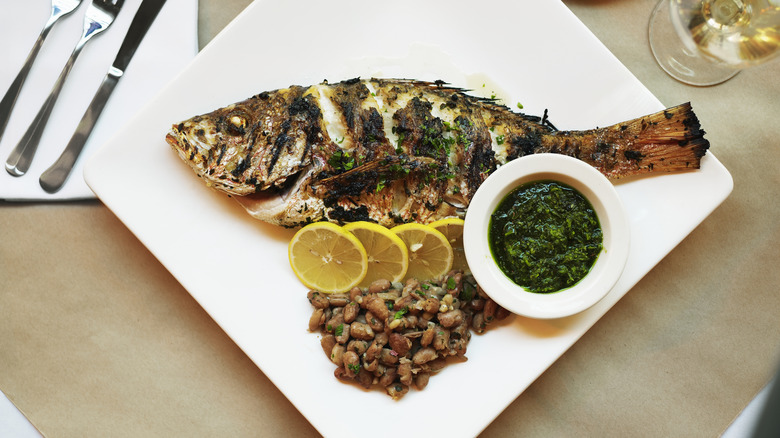12 Ways To Elevate Canned Anchovies
Anchovies are one of the most polarizing foods out there. When it comes to this funky, fishy ingredient, people either love them or hate them. While you might be most familiar with anchovies as a pizza topping or in a traditional Caesar salad, this ingredient is often a recipe's best-kept secret, used to deepen the meal's flavor. Adding a salty, umami-packed hit, there are many dishes you might not even realize have anchovies in them, like beef stew, broth, pasta sauce, or even chili.
There are many reasons why you should start putting anchovies in more recipes. Besides their taste, they also offer a number of health benefits. According to Healthline, they contain heart health-supporting nutrients like omega-3 fatty acids and selenium, and are a good source of protein. Like most canned or tinned fish, anchovies are an inexpensive way to bolster a meal and make something truly delicious. They are shelf-stable, so you can keep them in your pantry without the urgency to use them. Eating whole anchovy fillets out of the can is a stretch for some people, but the nifty thing about this should-be pantry staple is that these delicate little fillets break down and dissolve really easily, so they can often go undetected by picky eaters while still enhancing the flavor profile of your dish. You can also jazz them up in numerous, tasty ways.
1. Get fancy with anchovy butter
Compound butters are a food trend that we love because of the high payoff for something so easy to make. For a perfectly salty compound butter, open a can of anchovies. Anchovy butter might sound strange if you've never had it before, but it's truly a revelation. It couldn't be simpler to make, using just two ingredients (anchovies and butter), but the result is an incredibly tasty butter that will take any dish from ordinary to impressive. It's also just as good spread on some toast. The anchovies add a salty, umami depth to the butter while the fatty butter softens the anchovy pungence.
To make it, simply mash some anchovy fillets and add to softened butter. Then, mix them together until well combined. The anchovy bits should be evenly mixed throughout the butter so that one area isn't too salty and the other too bland. It's also possible to do this in a food processor, if you want the anchovies to be more finely minced, for a smoother spread. Anchovy butter is also the perfect way to use up a little bit of leftover anchovy if a whole can is too much for you. It can also be frozen once mixed together, which is a great way to reduce food waste and have something delicious on hand when you want to add a flourish to a piece of steak or fish.
2. Make anchovy carbonara
Carbonara is a massive crowd-pleaser, but for pescatarians or people who don't eat pork, you don't have to miss out. Use canned anchovies instead for a quick weeknight carbonara. While traditional carbonara is made with guanciale or pancetta (cured meats that perfectly balance richness and saltiness), anchovies will shine with this recipe — especially canned ones, because they've usually been preserved or cured in salt.
The other benefit of using anchovies is that they're usually cheaper than buying pancetta or guanciale — so even the non-pescatarians should give this a go. It's likely you'll add this to your weeknight repertoire as it comes together so quickly. For this recipe, the anchovies don't need to be precooked since they're ready to eat straight out of the can. They just need to be chopped and warmed up in a pan with your other ingredients (garlic and herbs like parsley work well — again, it's not a traditional carbonara) and then mixed in with your cooked pasta and egg mixture. If you're stuck on time, you don't need to heat them up separately. You can just add the anchovies to your cooked pasta and they'll warm up in a cinch.
3. Up the umami in your pesto with anchovies
People who have made their own pesto from scratch can attest to how much better it is than store-bought pesto. It's undeniably fresher and zestier. The best thing about making your own is that you can play around with ingredients and customize the sauce to your liking. This is where canned anchovies come in — just a few little anchovy fillets mixed into your pesto will make it instantly more flavorful. It's an obvious addition to traditional pestos which usually use salty, savory cheese like pecorino and parmesan. Anchovies will serve this exact purpose, given they have a strong salt and umami flavor too.
This is also a great way to slowly introduce anchovies to someone who thinks they hate the tinned fish. You'll be adding just a little to your pesto, so the sauce will taste rich and complex, but not too fishy or overpowering. You can use anchovy pesto in pasta or smeared on a grilled steak or fish, on sandwiches, roasted vegetables, and more.
4. Use anchovies as a marinade
If you're looking for something to spruce up your roasted beef or leg of lamb, look no further than an anchovy marinade. They're small but pack a punch, making them the perfect ingredient to mash up and add to any marinade. Much like how people might use Worcestershire sauce (which is also made with anchovies), using an anchovy marinade will season your meat and impart an extra meaty flavor that will enhance your dish, making it more savory and adding a funky complexity.
Anchovies are an inexpensive way to make your red meat feel like a luxurious gourmet meal. We recommend pairing them with complementary flavors, and they work especially well with capers, herbs like parsley and rosemary, and some lemon juice and zest. You can chop all these ingredients up and mix them, or mince them all together in pestle and mortar to create a thick and pungent marinade. You can add a drizzle of olive oil to moisten everything, or for an extra punch, add some of the oil from your canned anchovies to reinforce the anchovy flavor.
5. Dine Italian style with puttanesca
One of the popular ways to eat anchovies is with pasta, and there are a number of anchovy pasta recipes, both traditional Italian, and some non-traditional ones. If you want to give this combo a try but don't know how to approach it, a traditional Italian dish like spaghetti alla puttanesca is a good place to start. While some puttanesca recipes use canned tuna (which is also delicious), using canned anchovies is truer to the authentic recipe. The combination of anchovy, tomato sauce, capers, garlic, and olives work beautifully together, all bringing in loads of flavor so it doesn't taste overly fishy but still has a delicious seafood flavor.
The sauce for puttanesca comes together at about the same time as it takes to cook your pasta, so this is the perfect weekday meal. Drain and chop up your anchovy fillets. To make your sauce, sauté them in olive oil, along with the chopped garlic, olives, and capers before you add in some canned tomatoes.
6. Whip up anchovy paste
You may or may not know anchovy paste from your childhood. This old-school ingredient was often sold in jars or toothpaste-like tubes and often spread on toast for a quick bite. It was definitely for people who love anchovies, and for everyone else, it was incredibly off-putting. However, anchovy pastes can be a wonder if you know how to use them in your cooking. Especially if you're feeling a little bored in the kitchen, anchovy paste might be the salty flavor your dishes have been missing. If spreading it on toast isn't for you, you should use it as a kind of "umami paste" and add a little to dishes like your bolognese sauce or gravy. The paste will completely dissolve, and the taste of anchovies will be gone. You'll be left with your usual sauce with just a little more yummy intensity.
What's even better than using a store-bought anchovy paste is making the easy add-in at home. It will be more delicious, and you can customize the paste with whatever pairings you love. All you need is a pestle and mortar, or a food processor to mash everything up together. We recommend starting with a base of a few anchovy fillets, a glug of olive oil, and some salt. Then, you can keep it as is or include other flavorful ingredients like garlic, shallots, ginger, parsley, lemon juice, or tamarind.
7. Add anchovies to your aioli
By now you know that anchovies are an obvious choice for adding more flavor to dips and sauces, but one in particular is aioli. Aioli is a sort of cousin to mayo that's usually made with oil and garlic. Its creaminess makes the sauce a blank slate for different flavors — so it's perfect for anchovies. You can often find truffle aioli, chile aioli, and more, but it's rarer to find anchovy aioli. This is a shame because the saltiness of the anchovies adds the perfect balance to the rich condiment. Not to despair, though, because you can easily make your own — or even easier, add some anchovy flavor to a store-bought aioli.
You can use a small number of anchovy fillets and mash them into an aioli, but remember not to throw out the leftover anchovy oil from the can. The oil often has a concentrated flavor, so if you don't want to add mashed anchovies to your aioli, you can opt to mix in the oil from the can for a subtle anchovy taste without changing the condiment's color.
8. Forget bouillon, use anchovies for a flavorful stock
When you're making a broth, you're always chasing a complex and savory mouthfeel. The last thing you want is just warm, salty, lackluster water. This is why people spend hours boiling chicken bones, roasting their vegetables first, or turning to bouillon cubes, all in the hopes of achieving a deeper broth. Since anchovies contain a natural form of glutamate, the compound that gives cheese and mushrooms their savory taste, they're the perfect ingredient to add instant complexity to your broth. This is far from being a novel idea since anchovies have long been the base for making broth in Korean cuisine, which uses dried anchovies and kelp for various soups and stews.
Forget bouillon, and let anchovy paste flavor your stock. You can use canned anchovies to make your own homemade anchovy paste, or you can simply mash some up from the can and add them to your stock. They'll dissipate into the water over time so you won't be left with any fishy chunks. Plus, consider the added benefits: Anchovies are protein-rich, unlike bouillon, and don't contain the additives that bouillon has.
9. Use anchovies to beef up your beef stew
For meat eaters, there can be little as satisfying as letting a pot of beef stew simmer away for a cozy dinner. Adding a bunch of ingredients into a pot or slow cooker and leaving it to form a delicious, hearty meal can be really rewarding. What's even better is when the stew is packed with a rich, deep umami flavor. There are various ways that people achieve this — whether by adding some soy sauce or mushrooms, or by searing the beef first, everyone has their preferred technique. One more to add to your repertoire? Anchovies are the unexpected ingredient for a better beef stew.
Just a few chopped anchovies (or a little bit of anchovy paste) will add oodles of depth to your beef stew. And, although it might seem strange to add seafood to a meat stew, your stew won't taste at all like fish. Anchovies increase the meatiness of your beef because of their natural glutamate, which is why people often add Worcestershire sauce to their beef stew recipes. Simply sauté some chopped anchovies in with your onions and whatever other vegetables to create a base for your heartwarming meal.
10. Go classic with an authentic Caesar salad
In the U.S., people's first encounter with anchovies is often in a Caeser salad. It's a staple in many restaurants and the dressing, if authentic, is made with anchovies. These days, it's common to find Caesar salad with no anchovies because of how polarizing they are. In truth, it's a bit of a shame, because anchovies add the perfect bite to the creamy dressing, and are part of what makes Caeser salad so special. Plus, the creamy dressing also tones down the sharpness of the anchovies, so they're a match made in heaven.
Making a Caeser dressing at home is one of the most delicious ways to use up a can of anchovies. You can dress all types of salads with it — it's not limited to only Caesar salad ingredients. You can also make the dressing ahead of time and leave it in the fridge overnight. The flavors will marry and the dressing will taste even better the next day.
11. Make anchovy dip
Whether you love to snack or you're making some nibbles to serve to guests as an appetizer, anchovies can be integral in making something impressive but affordable. Anchovies make a great base for dips of all kinds, and adding a little anchovy to an artichoke dip or even to some ranch dressing will instantly lift the creaminess and make something incredibly flavorful. You can also turn to the French for inspiration, who love anchovies and are experts at making "aperitif," the little spread of snacks and dips to have with a drink before dinner. One particular dip is anchoïade, a French anchovy dip that you can make with just a few ingredients.
Hailing from Provence in the South of France, this salty dip is whipped up with some garlic, vinegar, and olive oil, making anchovies the only ingredient you'll need to get if you don't already stock some. You can also jazz it up with olives or nuts if you prefer different textures and flavors, or to slightly tone down the anchovies. Eat anchoïade with some crusty bread, crackers, or some crunchy, raw veggies like radishes, carrots, or crisp lettuce.
12. Try an anchovy salsa verde
With anchovies, a little goes a long way, which is why they work well in things like marinades, sauces, and dips to give a lot of flavor with just a fillet or two. They add incredible complexity without overpowering these foods because the other ingredients balance out the flavor profile — which is just the case with adding anchovies to your salsa verde. The anchovies add the salty intensity you want in a salsa and are counterbalanced with herbs, vinegar, and even chiles (if added). The result is an acidic, herbaceous condiment that can add brightness to all sorts of foods.
Anchovy salsa verde is a no-brainer for grilled steaks or fish. It also works surprisingly well on avocado toast, where the creamy avocado makes for the perfect neutral base for this zesty mixture. You can also drizzle some onto roasted potatoes, or even on your eggs. The possibilities are endless.
